Conrad Shawcross: exploring the work of British art’s brightest star
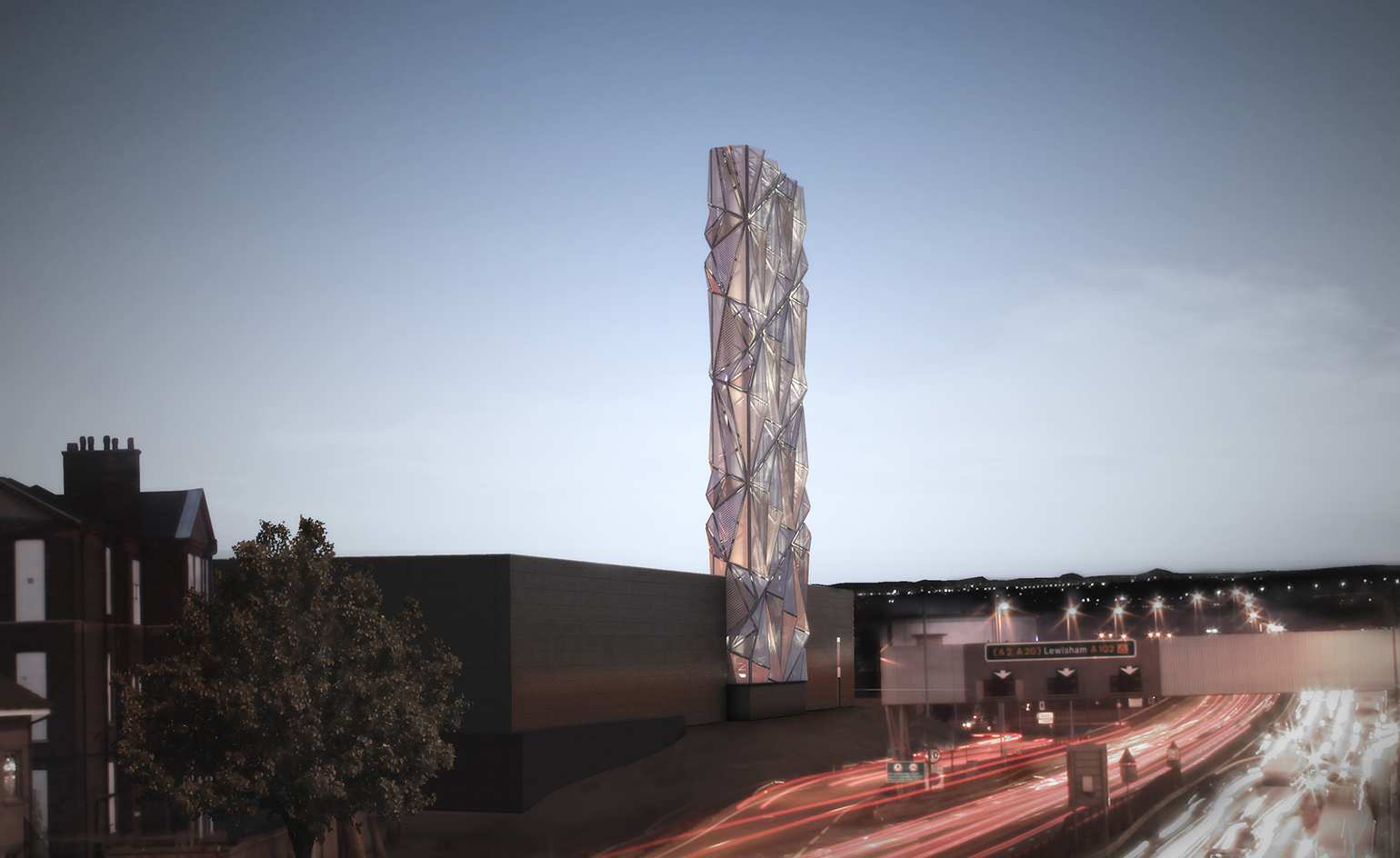
The youngish British artist Conrad Shawcross drives a Ford Capri. The closest a British-made car came to American muscle, he loves the ‘physical and visceral’ fun of driving it, the sheer effort it takes to haul its ridiculous nose around corners. It’s his second. He fitted a chair, fishing rods and a kite to the roof of his first and called it the Investigation Bureau into the Location of the Soul. Sadly, someone with a hard-to-locate soul nicked it.
While he was a student, Shawcross drove a Leyland Sherpa van, a Midlands-made rival to the Ford Transit. In reliability terms, it was everything the Transit was not; Shawcross bought a Haynes Manual and learnt to take the engine apart and put it back together again. ‘It was all quite mystical to me,’ he says. ‘I couldn’t imagine how people managed to make these things. They were so clever. But I learnt the language and how it works. And that was how I got into moving parts.’
Car engines are impenetrable black boxes now, and Shawcross laments the passing of Sundays when most men were elbow-deep in carburetors and sumps. Shawcross is handy, mechanically minded; a man of Swarfega and strong tea.
Now 38 and blessed with the looks and dark mess of hair of a bodice-ripper bit of rough, Shawcross has just completed the renovation of his large studio in Clapton, east London. It was once a stable for tram-pulling horses and one of the biggest taxidermists in London (Shawcross found the attic full of horns and hooves when he moved in). The entrance hall is tiled in off-cuts from the production of The Dappled Light of the Sun, his 6m-tall, 30-ton canopy of bifurcating steel tetrahedrons, which took over the Annenberg Courtyard at the Royal Academy of Arts last summer (he is the youngest living Royal Academician).
Shawcross has installed new living quarters for his wife and kids, as well as a sort of office with painted bare brick walls, random chairs and shelf space for various maquettes, models and other workings out. He won’t spend much time here, though, he says. He wants to be out in what is essentially a cavernous workshop, among the assistants he has trained in the art of welding and other metalworking skills. The office looks out over the first floor of the workshop – though most of that floor can be removed so he can weld and bolt to the full height of the building. Lurching uneasily towards the vaulted glass ceiling is a large model of Paradigm. Its final version has just been hoisted into place outside The Francis Crick Institute, a new biomedical research centre in King’s Cross, and it is currently the tallest public sculpture in central London.
Paradigm is essentially a twisting, turning stack of tetrahedral steel blocks that increase in size by ten per cent every twist. At 14m, it is as tall as it can possibly be without falling over (Shawcross has worked with structural engineers from Structure Workshop to ensure this), and widens from 1m at its base to 5m.
Paradigm and The Dappled Light of the Sun mark a turning point for Shawcross. His love of moving parts meant many of his early works were eccentric machines. He turned the Roundhouse in Camden into a giant clock/artificial sundial, called Timepiece; he installed Chord, a giant rope-making device in the disused Kingsway tram tunnel in Holborn; and made his name with Nervous System, an even more complex rope maker, back in 2003. Shawcross calls his early mechanical pieces a sort of ‘SAS art training’.
‘If you build a rope machine with a 150 different moving components, everything becomes easy after that,’ he says. ‘Those things were real head fucks.’
His newer pieces, though, have an internal, more organic dynamic; they seem almost self-generating. ‘As I have gotten older, I’ve had this realisation that the static works can actually contain much more movement than moving pieces,’ he says. ‘There is so much energy or potential energy in there, and Paradigm and The Dappled Light of the Sun contain a sense of time and growth. I find it bamboozling to think about plants and how they grow. Paradigm is quite similar to a tree, forcing itself up from the inside, so the oldest part is on the outside. And hopefully that is a very good metaphor for The Crick. A lot of people are excited by it, even economists and businessmen. They say, “Oh, it’s like compound growth! This is what happens to my ISA!”’
Shawcross – the son of writer and historian William Shawcross (who taught him to sail and passed on a love for ropes and rigging) and novelist and mythographer Dame Marina Warner – is a sort of throwback Victorian gentleman scientist/philosopher; a physicist and meta-physicist; a Renaissance man expressing himself in strange machinery, algorithms and harmonics-made material. Almost shockingly bright, he is a systems man, an observer of laws and relationships, and he sees them everywhere.
More than anything, though, he is a maker. And this place is a giant experimental shed. ‘I have invested a lot in this space so that we can make as much as we can in-house,’ he says. ‘I want to keep that familiarity with the process, just the fun of it, the noise and the experimentation. So we want to use bleeding-edge techniques but ancient stuff as well; keep a very open mind about old ways to make and new ways to make.’
Most of the workshop is taken up by two 16ft, 20-year-old industrial robots: a master Ada and a slave Ada, both named after Ada Lovelace, the pioneering mathematician and daughter of Lord Byron, who worked with Charles Babbage on his 19th-century proto-computer, the Analytical Engine. Lovelace designed the first algorithm to be carried out by a machine, so can claim to be the original computer programmer. Shawcross has something of an obsession with Lovelace and Babbage, and with long-retired technology. ‘Older things have this element of folly to them,’ he says, ‘because they have been replaced with superior things and now seem quite anachronistic or odd or eccentric. And a lot of the work, like the Ada project or my interest in Charles Babbage, is all to do with that idea of failure and the lonely endeavour.’
The Ada robots have now been replaced by superior designs, but Shawcross has learnt to make them do what he wants. In 2014, he made the robot dance to four original music pieces by women. With a 1,000w light bulb attached to her arm, Ada drew paths of light as the music played (both Adas are preparing to go on tour and will soon be shipped to The Peninsula hotel in Hong Kong, a Royal Academy-backed initiative set to coincide with Art Basel Hong Kong).
‘We have developed a lot of cutting-edge stuff working with a company called Robots in Architecture: parametric controls using Rhino and Grasshopper, and plug-ins that describe the pathway of the light bulb, but also the speed profile. Creating sinusoidal accelerations and decelerations is the key to it,’ he says. As a younger man Shawcross spent hours in the Science Museum’s Mathematics Gallery (recently redesigned by Zaha Hadid), and was the museum’s artist-in-residence from 2009–2011. He talks the language of maths, geometry and modelling unselfconsciously, as if everyone is as up to speed with sinusoidal accelerations as he is. His point, though, is that digital technology struggles to make smooth accelerations and decelerations in the way that analogue engineering can.
In recent years, Shawcross has also established a reputation for conceptual but approachable public art. Last April, his Three Perpetual Chords, a series of giant steel loops – ‘visual realisations of harmonic ratios’, as he calls them – landed in south London’s Dulwich Park, replacing Barbara Hepworth’s Two Forms (Divided Circle), stolen in 2011 (and still unrecovered).
On an even grander and more complex scale than Paradigm is The Optic Cloak, soon to loom, at a height of 50m, over London’s Greenwich Peninsula development. One of the largest developments in Europe, it will eventually house 30,000 people in seven new neighbourhoods across acres of derelict wasteland. Charged with providing power for the development is a new low-carbon energy centre, which will stand proud in a highly-visible pitch above the A12, just as it dips towards the Blackwall Tunnel. The building has had a somewhat complex genesis. Architect Terry Farrell designed a masterplan for the area ten years ago but development stalled. It was kickstarted in 2013 when Asian developer Knight Dragon bought out the entire project.
The London office of Danish architects CF Møller had produced an original design for the energy centre in 2007, and central to its design was 'The Blade', a series of four (though this may increase to nine) 50m-tall flues set into a slim, horizontal box. When Knight Dragon took over, it saw that the energy centre presented an opportunity to do something interesting; Shawcross won a competition to create an intervention on the site. CF Møller’s then-lead architect Chris Fay (now at Piercy & Company) says the centre’s strip of flues had potential as a grand stage. ‘By configuring the flues in a thin line, we could create a slender profile on the horizon and its orientation could provide a “canvas” for games to be played with transparency and light. We were always hopeful that money could be found so this could be done more powerfully.’ Luckily, Shawcross’ attachment to the project meant extra cash was found.
Shawcross understood from the beginning that the building – a bit of functional infrastructure – needed a lot of lift to make it the sort of totem of creativity and culture that Knight Dragon wanted. ‘The Blade was essentially a sort of 600-ton black steel box, a bit like a tombstone. And it was coming out of this obelisk.’
He set himself a double challenge, not just to surround the flues in a striking sculptural form, but to use less material than the original plans had envisioned and make the building lighter. ‘If you are going to build a low-carbon centre, then the building should be low carbon as well,’ he insists. ‘So I said, I can’t just bolt an artwork on to the side of this thing or make some huge projection that is going to use even more electricity and carbon. The world’s fucked if we all do this.’
Instead, Shawcross set out to do two seemingly contradictory things: to camouflage the flues, and to celebrate their very flueness. ‘All of my early research went into camouflage and how you can break up a surface,’ he says. ‘So I just started folding paper and creating a repeated folding surface.
‘I was interested in the fact that camouflage has this paradoxical thing where it makes something hypothetically disappear against a background but at the same time is very arresting. I was looking at dazzle camouflage in the First World War and these incredibly vibrant ships, and the relationship with cubism and Picasso and Picabia; that paradox of making something disappear but also more magnificent. But then I also wanted to celebrate it as a flue. We wanted to open everything up, make it very utilitarian, structural and practical. A bit like the Lloyd’s building. Just sort of show it.’
Key to Shawcross’ camouflage idea was conjuring up a moiré pattern on a grand scale. Put simply, a moiré pattern is a third pattern created when two transparent (or semi-transparent) but identically-patterned flat surfaces are overlaid at odd angles. ‘The unique thing about this building is how thin it is, and how long and how tall. That was the idea of trying to use both surfaces, so you get this kind of shimmering effect,’ he says. ‘We did exhaustive studies of different hole sizes, the pitch of the holes, the pattern of the holes, tests of different distances, angles, orientations, to harness the moiré effect as much as possible.
‘It is part of the urban realm. You see [moiré] on service bridges on the M25,’ says Shawcross, ‘where you have mesh on the back and front. It’s better on a sunny winter’s day, but it creates this intense optic effect.’ It’s this dynamic effect he’s been trying to create.
‘We are trying to disrupt people’s everyday, automaton response, so when you are driving on the A12, just creeping towards the Blackwall Tunnel, you will get this oscillation. And at night it will be lit from inside, appearing like a series of abstract compositions. I have a vision of a housewife washing up, looking up, seeing the tower every night, and every night there is a different painting outside her window.’
Shawcross’ intervention did make the building lighter. ‘The piece is a frame with diagonals that go across, and wrap around it. And that makes it much stiffer. We have cut down the weight by 40 per cent.’
Teva Hesse, head of Møller’s London office, agrees that Shawcross has lifted the original design to a new level. ‘Conrad’s work has brought a new dimension to the project, so how could we be less than delighted? The result is more interesting when artist and architect and engineer push each other to do something better.’
If The Optic Cloak is considered a success, we may see more artist interventions in architectural projects and less grand-standing public art plonked in plazas and public spaces. Hesse would welcome such a move. ‘We are seeing an interesting period of intersection between architecture and art,’ says Chris Fay. ‘On the one hand, we have artists such as Thomas Heatherwick practising in architecture and on the other we have Assembly winning the Turner Prize. Selfishly, I hope this can reinvigorate the profession rather than devalue it.’
Shawcross says he toyed with the idea of becoming an architect when he was a teenager. ‘I just didn’t have the patience for it, though,’ he admits. ‘Ironically, I was probably at art school longer than I would have been at architecture school. I did about eight years of art school. There are also all the restraints, regulations and bureaucracy around architecture that are frustrating. Sculpture doesn’t have those regulations, thank god.’
He does fancy designing a house, though. He leads me into the kitchen to show me a model from a series of pieces called Plosions. It’s a shiny, solid icosahedron (a 20-sided polyhedron, in case you were wondering) and looks like a twinkling star in 3D. Shawcross wants to build a house in this shape and a collector has a spot in Mexico he imagines might be perfect – but discussions are still in their early stages.
It’s hard to predict where Shawcross – the very definition of a restless intelligence – will go in the long run. At the moment he is investigating what art can do in the public realm; how it can not only work alongside architecture but be architecture. But you feel sure that whatever he does won’t take him far from this workshop, from the sparks and grindings, from ancient physical laws imagined in steel and light.
As originally featured in the April 2016 issue of Wallpaper* (W*205)
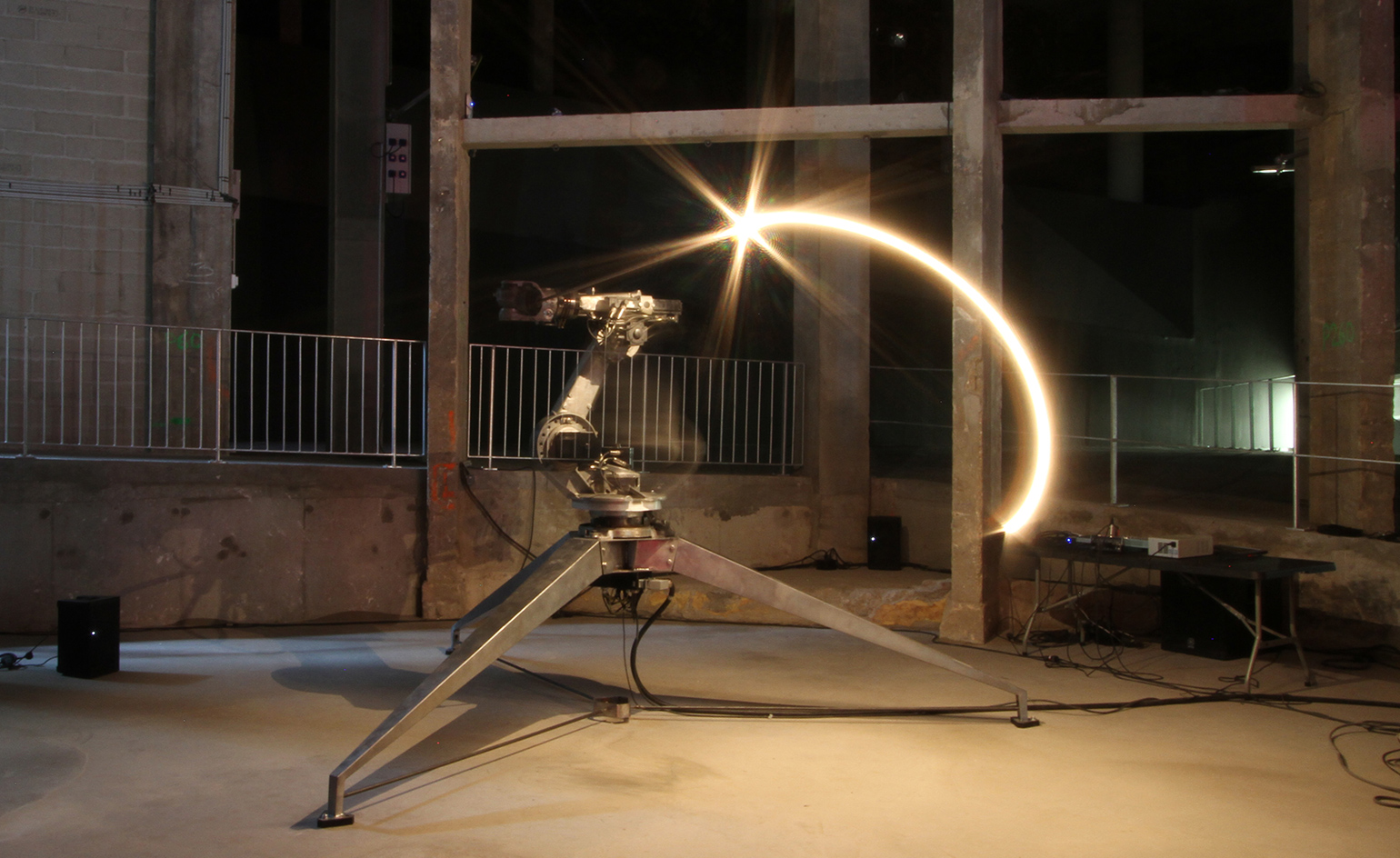
Most of the workshop is taken up by two 20-year-old industrial 'Ada' robots; both are named after Ada Lovelace, the pioneering mathematician and daughter of Lord Byron, who helped develop the proto-computer. Pictured: a dancing Ada robot
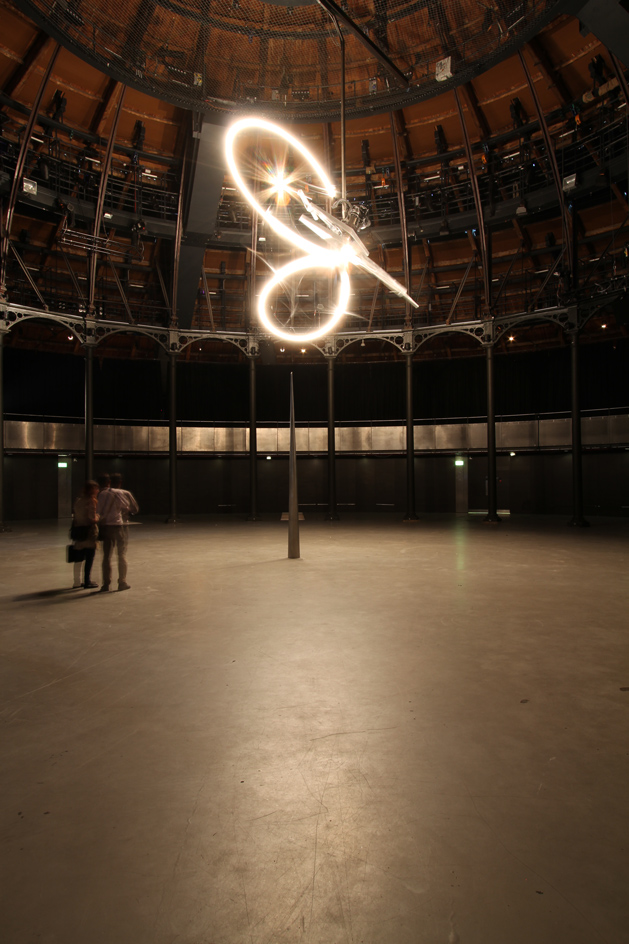
Shawcross turned the Roundhouse in Camden into a giant clock/artificial sundial, called Timepiece in 2013 (pictured)
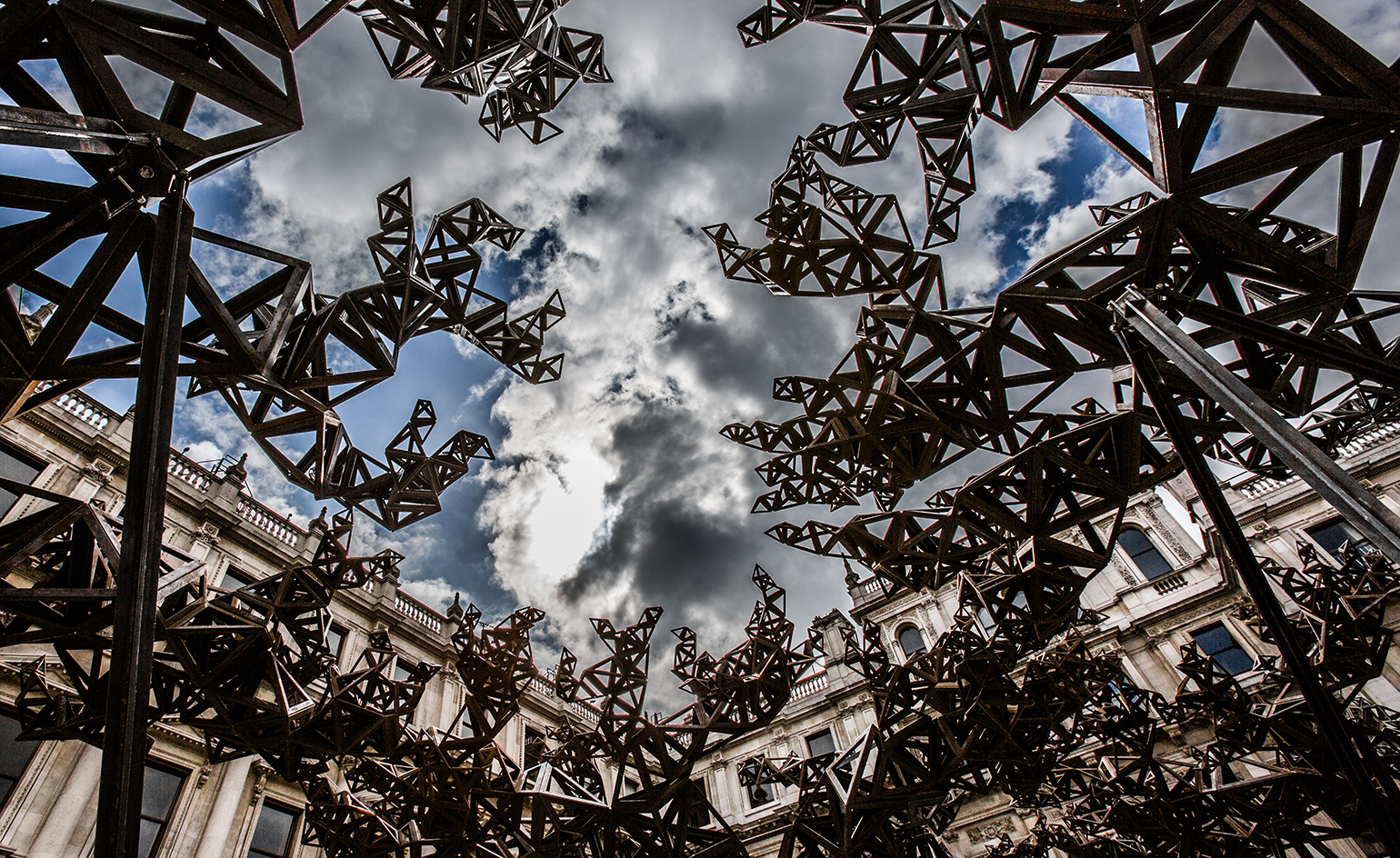
The workshop's entrance hall is tiled in off-cuts from the production of The Dappled Light of the Sun (pictured), his 6m-tall, 30-ton canopy of bifurcating steel tetrahedrons, which took over the Annenberg Courtyard at the Royal Academy of Arts last summer
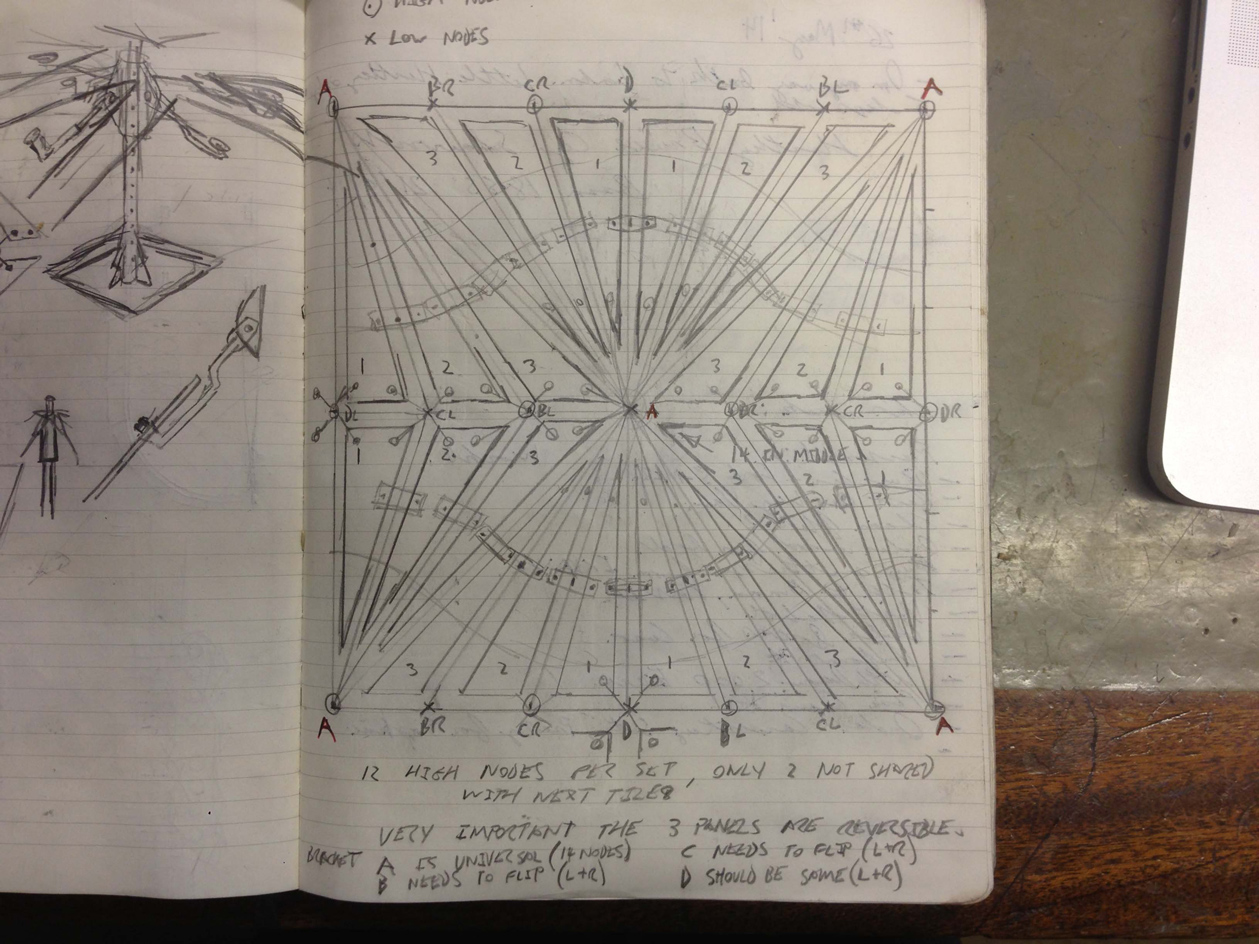
If The Optic Cloak is considered a success, we may see more artist interventions in architectural projects and less grand-standing public art plonked in plazas and public spaces. Pictured: The Optic Cloak sketch sub panels
INFORMATION
For more information, visit Conrad Shawcross’ website
Photography: Daniel Stier
Wallpaper* Newsletter
Receive our daily digest of inspiration, escapism and design stories from around the world direct to your inbox.
-
 Japan in Milan! See the highlights of Japanese design at Milan Design Week 2025
Japan in Milan! See the highlights of Japanese design at Milan Design Week 2025At Milan Design Week 2025 Japanese craftsmanship was a front runner with an array of projects in the spotlight. Here are some of our highlights
By Danielle Demetriou
-
 Tour the best contemporary tea houses around the world
Tour the best contemporary tea houses around the worldCelebrate the world’s most unique tea houses, from Melbourne to Stockholm, with a new book by Wallpaper’s Léa Teuscher
By Léa Teuscher
-
 ‘Humour is foundational’: artist Ella Kruglyanskaya on painting as a ‘highly questionable’ pursuit
‘Humour is foundational’: artist Ella Kruglyanskaya on painting as a ‘highly questionable’ pursuitElla Kruglyanskaya’s exhibition, ‘Shadows’ at Thomas Dane Gallery, is the first in a series of three this year, with openings in Basel and New York to follow
By Hannah Silver
-
 ‘Humour is foundational’: artist Ella Kruglyanskaya on painting as a ‘highly questionable’ pursuit
‘Humour is foundational’: artist Ella Kruglyanskaya on painting as a ‘highly questionable’ pursuitElla Kruglyanskaya’s exhibition, ‘Shadows’ at Thomas Dane Gallery, is the first in a series of three this year, with openings in Basel and New York to follow
By Hannah Silver
-
 The art of the textile label: how British mill-made cloth sold itself to Indian buyers
The art of the textile label: how British mill-made cloth sold itself to Indian buyersAn exhibition of Indo-British textile labels at the Museum of Art & Photography (MAP) in Bengaluru is a journey through colonial desire and the design of mass persuasion
By Aastha D
-
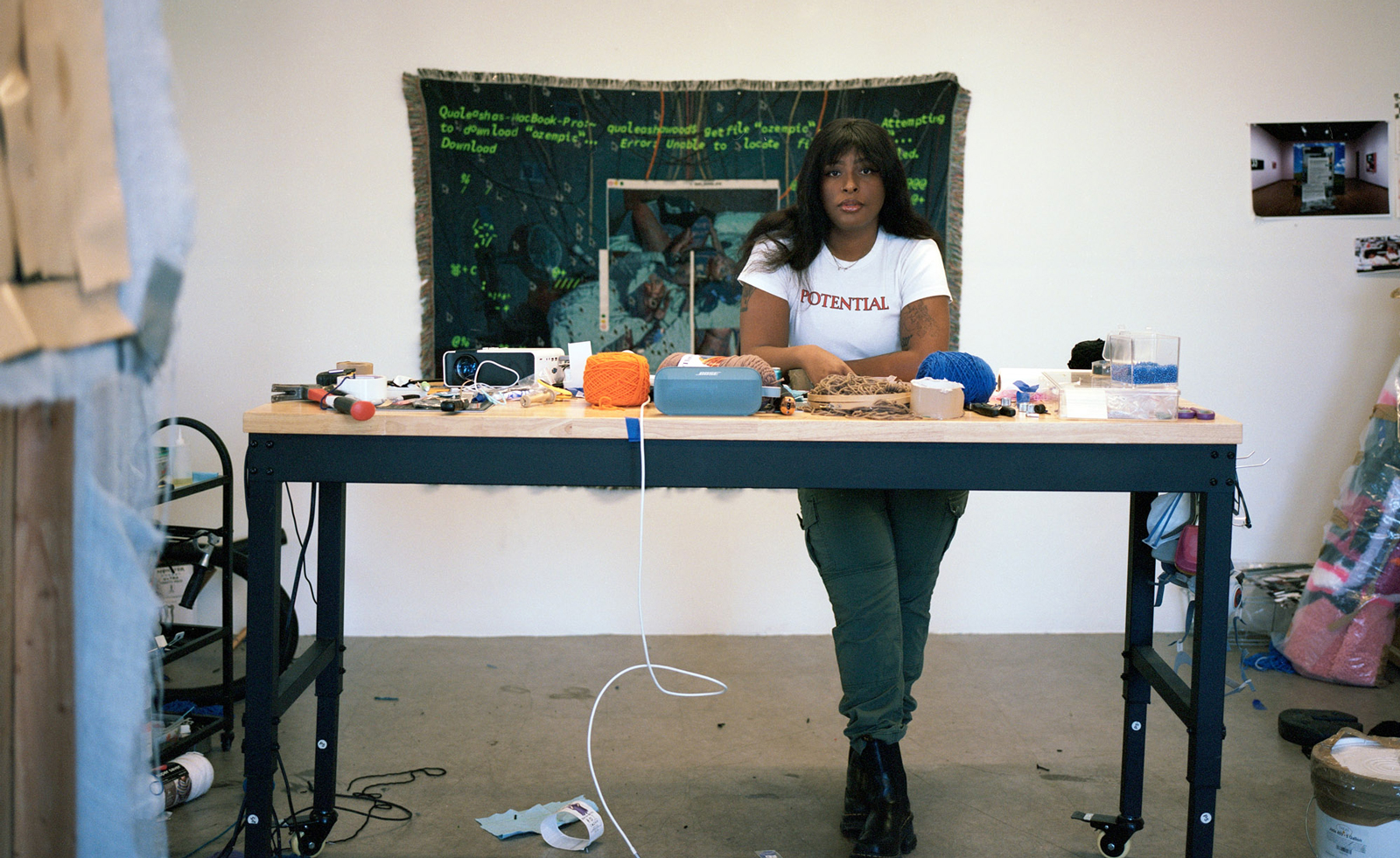 Artist Qualeasha Wood explores the digital glitch to weave stories of the Black female experience
Artist Qualeasha Wood explores the digital glitch to weave stories of the Black female experienceIn ‘Malware’, her new London exhibition at Pippy Houldsworth Gallery, the American artist’s tapestries, tuftings and videos delve into the world of internet malfunction
By Hannah Silver
-
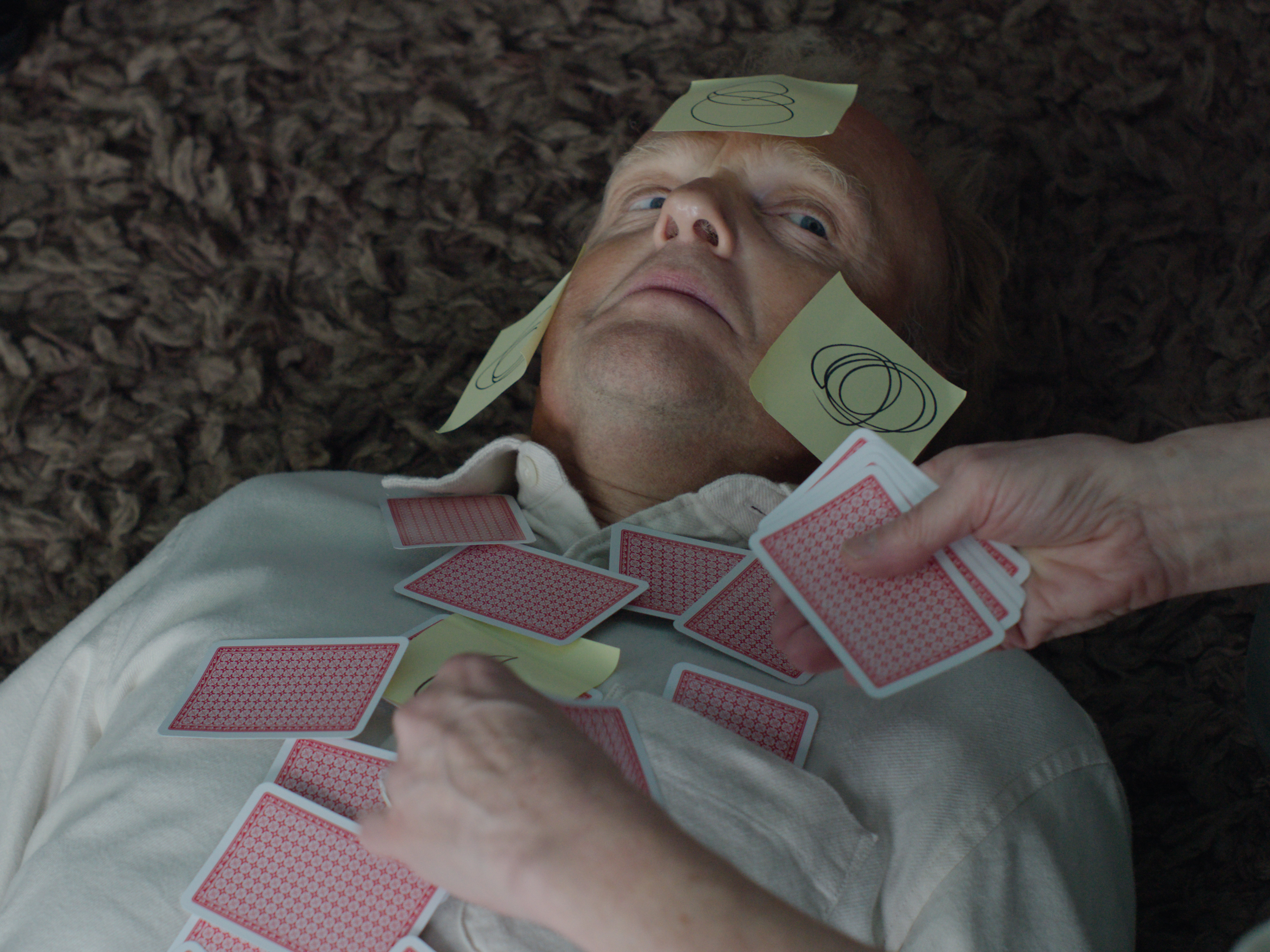 Ed Atkins confronts death at Tate Britain
Ed Atkins confronts death at Tate BritainIn his new London exhibition, the artist prods at the limits of existence through digital and physical works, including a film starring Toby Jones
By Emily Steer
-
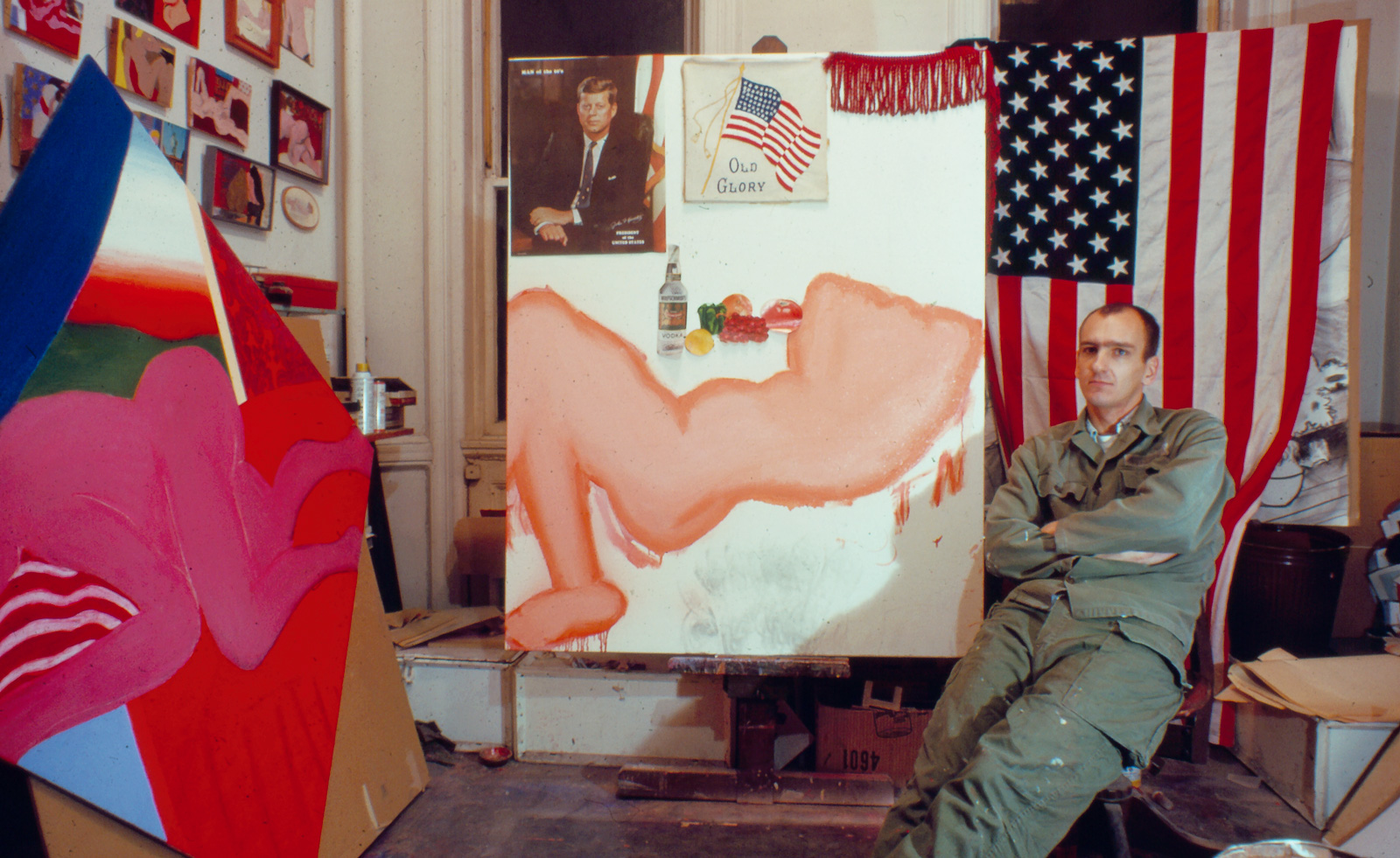 Tom Wesselmann’s 'Up Close' and the anatomy of desire
Tom Wesselmann’s 'Up Close' and the anatomy of desireIn a new exhibition currently on show at Almine Rech in London, Tom Wesselmann challenges the limits of figurative painting
By Sam Moore
-
 A major Frida Kahlo exhibition is coming to the Tate Modern next year
A major Frida Kahlo exhibition is coming to the Tate Modern next yearTate’s 2026 programme includes 'Frida: The Making of an Icon', which will trace the professional and personal life of countercultural figurehead Frida Kahlo
By Anna Solomon
-
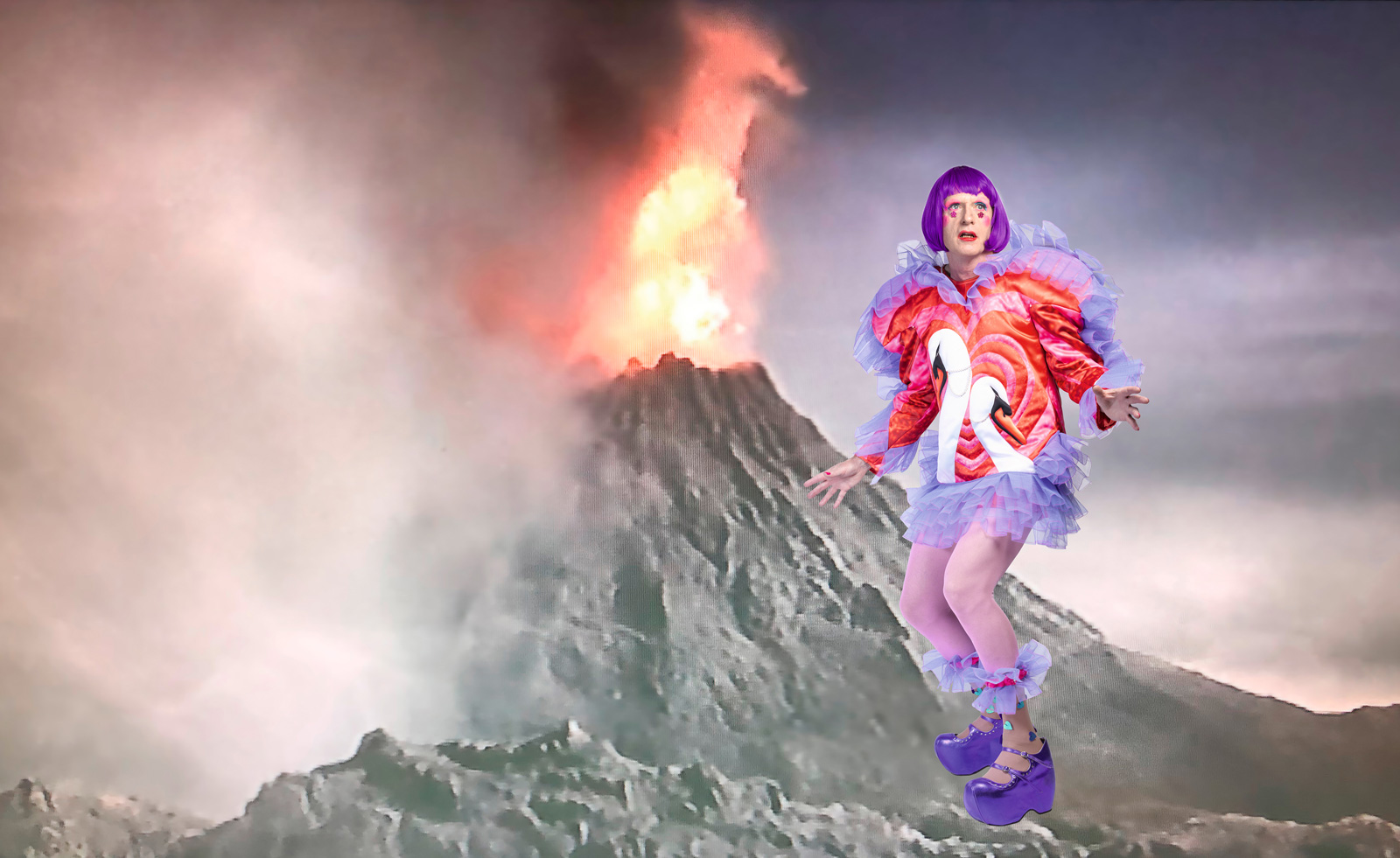 A portrait of the artist: Sotheby’s puts Grayson Perry in the spotlight
A portrait of the artist: Sotheby’s puts Grayson Perry in the spotlightFor more than a decade, photographer Richard Ansett has made Grayson Perry his muse. Now Sotheby’s is staging a selling exhibition of their work
By Hannah Silver
-
 From counter-culture to Northern Soul, these photos chart an intimate history of working-class Britain
From counter-culture to Northern Soul, these photos chart an intimate history of working-class Britain‘After the End of History: British Working Class Photography 1989 – 2024’ is at Edinburgh gallery Stills
By Tianna Williams